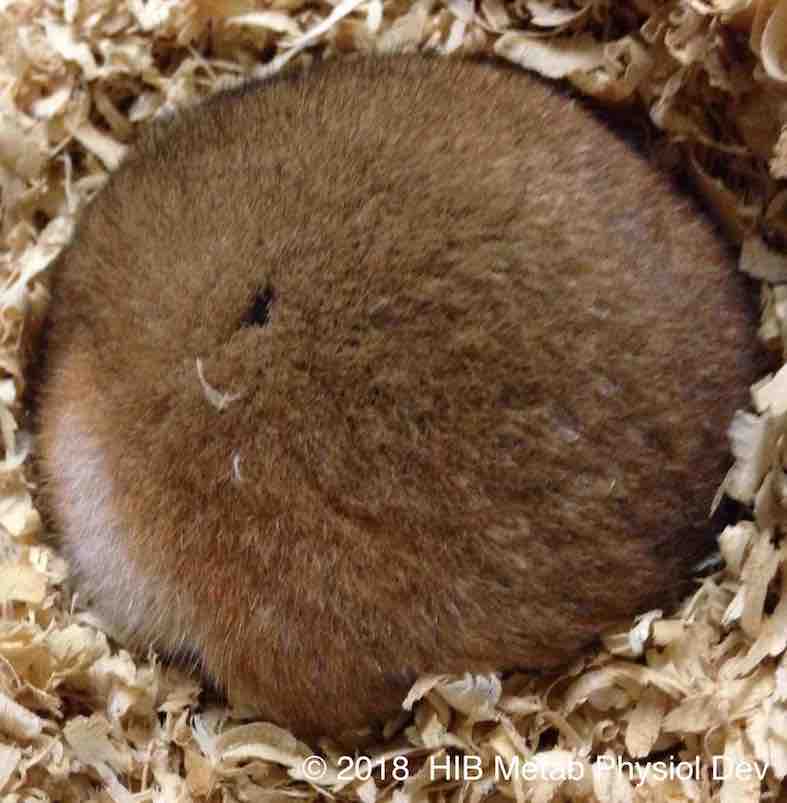What is Hibernation?
Why study Hibernation?

(Hibernating Syrian hamster)
Hibernation is a phenomenon that allows animals to survive with suppression of metabolisms and very low body temperature in a long winter. We human beings and many mammals are homeotherms whose body temperature are maintained constant at around 37 ºC and therefore can not hibernate under such a very low body temperature, because tissues and cells will be damaged and the heart will stop beating if hypothermic condition persists for a long time. In contrast, some mammals called hibernators can survive for a long period under very low body temperature.
Nonetheless, hibernators cannot hibernate at all times throughout a year. For the success of hibernation, their body must be adapted for winter environment. But there remain a lot of mysteries in hibernation; What is the difference between the summer body and the winter body? What brings about these differences together with changes in the seasons and the environment? How can the animals endure prolonged severe hypothermia during hibernation?
As questions answering to which may relate to and be useful for humans, the following questions exist . Hibernators accumulate a lot of fats in autumn, and survive the winter by burning fat efficiently during the winter. The mechanisms for efficient accumulation and utilization of fat are not well understood yet. Also, while the animals stay almost bedridden during hibernation, their muscles do not decay so much. In addition, "seasonal affective disorder (SAD)" might be a remnant of hibernation that could have been experienced during human evolution. SAD is often observed in people living at higher latitude; they experience feeling low or sleepy from the end of autumn to winter, partly due to decrease of sunlight. But if such symptoms become worse, it will cause difficulties in daily life.
Thus, tackling the mystery of hibernation would give important hints for us to understand not only hibernators but also human beings. Discovering the mechanisms of hidden powers of animals would definitely extend our view and understanding of life. From that point onwards, seeds of new invention will be found. We believe that hibernation research is a frontier left for biology and medicine of the 21st century.
Publication on mammalian hibernation
Chayama, Y., Ando, L., Tamura, Y., Miura, M., *Yamaguchi, Y. Decreases in body temperature and body mass constitute pre-hibernation remodelling in the Syrian golden hamster, a facultative mammalian hibernator.
Royal Society Open Science, 3, 160002, 2016. DOI: 10.1098/rsos.160002.
Chayama Y, Ando L, Sato Y, Shigenobu S, Anegawa D, Fujimoto T, Taii H, Tamura Y, Miura M, and *Yamaguchi Y. Molecular basis of white adipose tissue remodeling that precedes and coincides with hibernation in the Syrian hamster, a food-storing hibernator.
Frontiers in Physiology, 28 Jan 2019, doi:10.3389/fphys.2018.01973
Anegawa D,Sugiura Y, Matsuoka Y, Sone M, Shichiri M, Otsuka R, Ishida N, Yamada KI, Suematsu M, Miura M, *Yamaguchi Y. Hepatic resistance to cold ferroptosis in a mammalian hibernator Syrian hamster depends on effective storage of diet-derived α-tocopherol.
Communications Biology. 4:796, 2021. doi: 10.1038/s42003-021-02297-6.
Yoshimatsu S, Yamazaki A, Edamura K, Koushige Y, Shibuya H, Qian E, Sato T, Okahara J, Kishi N, Noce T, Yamaguchi Y, *Okano H.
Step-by-step protocols for non-viral derivation of transgene-free induced pluripotent stem cells from somatic fibroblasts of multiple mammalian species.
Dev Growth Differ. 64(6):325-341, 2022. doi: 10.1111/dgd.12798.
Nakagawa S, Yamaguchi Y.
Spontaneous recurrence of a summer-like diel rhythm in the body temperature of the Syrian hamster after hibernation.
Proc Biol Sci. 290(2009):20230922, 2023. doi: 10.1098/rspb.2023.0922.
*Enoki R, Kon N, Shimizu K, Kobayashi K, Hiro S, Chang CP, Nakane T, Ishii H, Sakamoto J, Yamaguchi Y, Nemoto T.
Cold-induced suspension and resetting of Ca2+ and transcriptional rhythms in the suprachiasmatic nucleus neurons.
iScience. 26(12):108390. 2023. doi: 10.1016/j.isci.2023.108390.
*Sone M, Mitsuhashi N, Sugiura Y, Matsuoka Y, Maeda R, Yamauchi A, Okahashi R, Yamashita J, Sone K, Enju S, Anegawa D, *Yamaguchi Y. Identification of genes supporting cold resistance of mammalian cells: lessons from a hibernator.
bioRxiv 2023.12.27.573489; doi: https://doi.org/10.1101/2023.12.27.573489
*Sone M, Yamashita J, Shigenobu S, *Yamaguchi Y. Slow decrease in temperature produces readthrough transcripts in mammalian hibernation.
Biochem Biophys Res Commun. doi.org/10.1016/j.bbrc.2024.149837, in press
Publication on cell death & development
(selected)
Matsumoto Y, *Yamaguchi Y, Hamachi M, Nonomura K, Muramatsu Y, Yoshida H, *Miura M.
Apoptosis is involved in maintaining the character of the midbrain and the diencephalon roof plate after neural tube closure. Developmental Biology. 468(1-2):101-109, 2020.
Miyazawa, H., *Yamaguchi, Y., Sugiura, Y., Honda, K., Kondo, K., Matsuda, F., Yamamoto, T., Suematsu, M., and *Miura, M.
Rewiring of embryonic glucose metabolism via suppression of PFK-1 and aldolase during mouse chorioallantoic branching. Development , 144, 63-73, 2017.
*Yamaguchi, Y., *Miura, M.
Programmed cell death in neurodevelopment. Developmental Cell, 32, 478-490. 2015.
Liu, T., *Yamaguchi, Y., Shirasaki, Y., Shikada, K., Yamagishi, M., Hoshino, K., Kaisho, T., Takemoto, K., Suzuki, T., Kuranaga, E., Ohara, O., and *Miura, M.
Single-cell imaging of caspase-1 dynamics reveals all-or-none response to inflammasome signaling. Cell Reports, 8, 974-982, 2014.
Nonomura, K., *Yamaguchi, Y., Hamachi, M., Koike, M., Uchiyama, Y., Nakazato, K., Mochizuki, A., Sakaue-Sawano, A., Miyawaki, A., Yoshida,H., Kuida, K., *Miura, M.
Local apoptosis modulates early mammalian brain development through the elimination of morphogen-producing cells. Developmental Cell, 27, 621-634, 2013.
*Yamaguchi, Y., Shinotsuka, N., Nonomura, K., Takemoto, K., Kuida, K., Yoshida, H., *M. Miura.
Live-imaging of apoptosis in a novel transgenic mouse highlights its role in neural tube closure. Journal of Cell Biology, 195, 1047-1060, 2011.
Last update: 2024.9.14